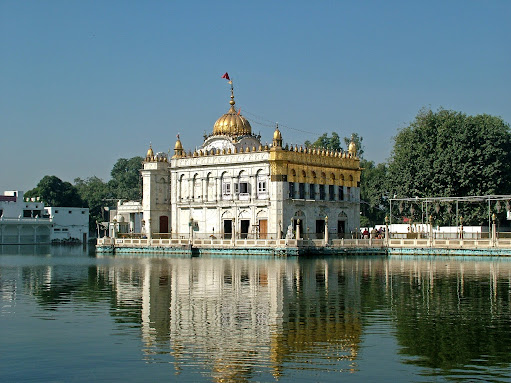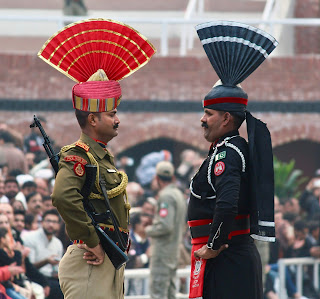Most HIghlight of punjab
About
Punjab, a state bordering Pakistan, is the heart of India’s Sikh community. The city of Amritsar, founded in the 1570s by Sikh Guru Ram Das, is the site of Harmandir Sahib, the holiest gurdwara (Sikh place of worship). Known in English as the Golden Temple, and surrounded by the Pool of Nectar, it's a major pilgrimage site. Also in Amritsar is Durgiana Temple, a Hindu shrine famed for its engraved silver doors.
GOLDEN TEMPLE
Golden Temple The Golden Temple Amritsar India (Sri Harimandir Sahib Amritsar) is not only a central religious place of the Sikhs, but also a symbol of human brotherhood and equality. Everybody, irrespective of cast, creed or race can seek spiritual solace and religious fulfilment without any hindrance.
Amritsar is a city in the northwestern Indian state of Punjab, 28 kilometers from the border with Pakistan. At the center of its walled old town, the gilded Golden Temple (Harmandir Sahib) is the holiest gurdwara (religious complex) of the Sikh religion. It’s at the end of a causeway, surrounded by the sacred Amrit Sarovar tank (lake), where pilgrims bathe
Land of Golden Temple
The land for the site was bought by the Guru Ram Das Sahib on payment from the Zamindars (landlords) of native villages. Some people says that the land for Golden Temple was donated by Mughal Emperors, but this is not true.
The land for the city of Amritsar belongs to the villages Tung, Sultan wind, Gilwali and Gumtala. These particular villages came under tehsil Patti and Distt. Chhabal during the Guru’s time.
Guru Amardas Ji (Third Sikh Master) alongwith Guru Ram Das, Baba Budha Ji (a great devotee of Sikh Religion) visited and found a lonely and peaceful area in the centre of these villages. At that time this piece of land (The walled city of Amritsar) was bought from the villagers for 700 Rs. During the times of Maharaja Ranjit Singh and the British Empire, the city was free from the state taxes.
Guru Arjun Sahib got its foundation laid by a muslim saint Hazrat Mian Mir ji of Lahore on 1st of Magh, 1645 Bikrmi Samvat (December, 1588). The construction work was directly supervised by Guru Arjan Sahib himself and he was
assisted by the prominent Sikh personalities like Baba Budha, Bhai Gurdas ji, Bhai Sahlo ji, and many other devoted Sikhs.
Unlike erecting the structure on the higher level (a tradition in Hindu Temple architecture), Guru Arjan Sahib got it built on the lower level and unlike Hindu Temples having only one gate for the entrance and exit, Guru Sahib got it open from four sides. Thus he created a symbol of new faith, Sikhism. Guru Sahib made it accessible to every person without any distinction of Caste, creed, sex and religion.
The building work completed in 1601 A.D. on Bhadoon Sudi 1st, 1661 Bikrmi Samvat (August/September,1604). Guru Arjan Sahib installed newly created Guru Granth Sahib, in Sri Harmandir Sahib and appointed Baba Budha ji as its first Granthi i.e. the reader of Guru Granth Sahib. After this event it attained the status of ‘Ath Sath Tirth’ Now the Sikh Nation had their own Tirath, a pilgrimage center.
Sri Harmandir Sahib, is built on a 67ft. square platform in the centre of the Sarovar (tank). The temple itself is 40.5ft. square. It has a door each on the East, West, North and South. The Darshani Deori (an arch) stands at the shore end of the causeway. The door frame of the arch is about 10ft in height and 8ft 6inches in breath. The door panes are decorated with artistic style. It opens on to the causeway or bridge that leads to the main building of Sri Harmandir Sahib. It is 202 feet in length and 21 feet in width.
The bridge is connected with the 13 feet wide ‘Pardakshna’ (circumambulatory path). It runs round the main shrine and it leads to the ‘Har ki Paure’ (steps of God). On the first floor of "Har Ki Pauri", there is continuous reading of Guru Granth Sahib.
Sri Harmandir Sahib, is built on a 67ft. square platform in the centre of the Sarovar (tank). The temple itself is 40.5ft. square. It has a door each on the East, West, North and South. The Darshani Deori (an arch) stands at the shore end of the causeway. The door frame of the arch is about 10ft in height and 8ft 6inches in breath. The door panes are decorated with artistic style. It opens on to the causeway or bridge that leads to the main building of Sri Harmandir Sahib. It is 202 feet in length and 21 feet in width.
The bridge is connected with the 13 feet wide ‘Pardakshna’ (circumambulatory path). It runs round the main shrine and it leads to the ‘Har ki Paure’ (steps of God). On the first floor of "Har Ki Pauri", there is continuous reading of Guru Granth Sahib.
Durgiana Temple
About
Shri Durgiana Mandir, is a Hindu temple situated in the city of Amritsar, Punjab, India. Though a Hindu temple, its architecture is similar to the Sikh Harmandir Sahib. This temple derives its name from the Goddess Durga, the chief Goddess who is worshipped here. Murtis of Lakshmi and Vishnu are also located and worshipped in the temple. Although it is believed that Durgiana Mandir was built in 1921, the temple existed before it was rebuilt in 1921. It is confirmed by record in Amritsar District Gazetteer of 1893, which talks about Durgiana Sarovar and "Devi dwara" surrounding it which was thronged by Hindu pilgrims.
It is a Hindu temple, yet it has been constructed according to the architecture of the Golden Temple of Sikhism. The foundation stone of this grand temple was laid by Pandit Madan Mohan Malaviya, a renowned social reformer and politician of the country. This temple is one of the beautiful Hindu temples built in the 20th century.
Durgiana Temple is situated near Lohgarh Gate. The temple is also famous as the Silver Temple for its intricately carved silver doors. The temple also has idols of Goddess Lakshmi (the goddess of wealth) and Vishnu (the preserver of creation) who are worshiped here.
It is said that the history of this Hindu temple dates back to the 16th century, when the efforts of Guru Harsaimal Kapoor started the reconstruction of the temple after collecting funds and in terms of architecture, inspiration was taken from the Golden Temple of the Sikhs. In 1925, on the day of Ganga Dashmi, the foundation stone of Durgiana Temple was laid by the hands of Pt. Madan Mohan Malaviya.
Wagah Border
The Wagah border is a post between India and Pakistan. It has become famous for the beating the retreat ceremony which includes the closing of international gates and the lowering of the flags of both the countries. Around 5000 people visit the Wagah...
The Wagah Border Ceremony, more popularly known as Beating Retreat Ceremony, was started in 1959 and it was agreed by the government of both the countries. It is a symbol of the rivalry between the two nations, as well as the cooperation and brothe...
It was not Wagah but Attari village that lay on the India side of this international boundary, they discovered. Thus, on 8th September 2007, the Government of India officially named this stretch of the international boundary, from the prevalent name of 'Wagah Border' to the 'Attari Border'
India developed its first Land Port at Attari along the international border between India and Pakistan, located at a distance of about 28 kms from the city of Amritsar.
Jallianwala Bagh massacre
The Jallianwala Bagh massacre, also known as the Amritsar massacre, took place on 13 April 1919, when Acting Brigadier-General Reginald Dyer ordered troops of the British Indian Army to fire their rifles into a crowd of unarmed Indian civilians in Jallianwala Bagh, Amritsar, Punjab, killing at least 379 people and injuring over 1,200 other people.
Jallianwala Bagh
Located near the famous Golden Temple of Amritsar, the Jallianwala Bagh is a public garden which houses a memorial to commemorate the massacre of peaceful celebrators by the British forces.
Gobindgarh Fort
The Fort was captured by the British after the Second Anglo-Sikh War in 1849. After Independence, the Fort was garrisoned by the Indian army in 1947. Gobindgarh has been at the very heart of political events in Punjab for most of its existence.
Gobindgarh Fort is a historic military fort located in the center of the city of Amritsar in the Indian state of Punjab. The Fort was until recently occupied by the army but was opened to the public from 10 February 2017
Maharaja Ranjit Singh, the first maharaja of the Sikh Empire, conquered the fort in the early 19thcentury. It was he who renamed it as Gobindgarh Fort after Guru Gobind Singh, the 10th guru of the Sikhs. Further, he made many renovations and added new structures to the fort from 1805 to 1809.
Maharaja Ranjit Singh
Ram Tirth Mandir
An Important pilgrimage for the Hindus, Ram Tirath Temple dates back to the Ramayana Period. It is believed to be the ashram of Sage Valmiki, where Mata Sita took shelter on being abandoned by her husband Lord Rama. Luv and Kush, the sons of lord Rama are believed to have been born here.
221.jpg)








Comments
Post a Comment